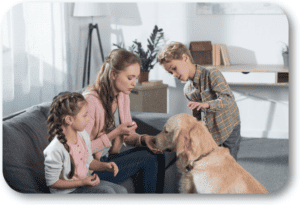I was in Norcross last Thursday at a new Home Dog Training client working with the family and their one-year-old Aussiedoodle named Doodle. Our lesson was very productive, and Doodle was quite fast in learning to obey my client’s commands and providing her with respectful and calm focus. As the lesson was wrapping up, my client told me that she had one more question that she needed answered.

I was really happy that she brought up this subject because it is one of my “pet peeves” and something all families need to appreciate. “From time to time, when the kids play with Doodle, he gets a little too hyper and seems out of control. Now and then my kids get frightened when Doodle starts to act this way. What can I do to make sure that my kids can interact with Doodle and everyone is happy?”
As parents, we always want our children to have a wonderful relationship with our family dog. We want them to create a long and lasting bond and learn to always love animals. (In my humble opinion), having a family dog is one of the “iconic and wonderful family experiences” that follow us from being kids ourselves to being parents.
Our goal is to walk the fine line between having the experience filled with memorable and somewhat crazy times and the experience of highly agitated and possibly scary situations. To be clear, we don’t want to stifle the experience of our kids having fun and silly times with our dog. With that said, we don’t want our children frightened every time they see the dog. Here are some ideas that I offered our client:
- Always make sure that your young children (in this case, we define “young” as eight years old or younger) only engage in playtime with your family dog if there is an adult present. The adult should be constantly managing all activities between the children and the dog.
- It is always best if your dog remains on a leash (six feet is best) when your young kids are playing with him. The adult doesn’t need to always be holding the leash but have it easily within “quick grabbing distance”, if needed. This assures that you can easily separate your dog from the kids if things get out of hand.
- Make sure that your kids understand that poking and pulling the dog is not a proper play activity. This type of active, physical activity often increases your dog’s adrenaline and mimics a “tag, you’re it” situation. Your dog will often respond by nipping and jumping. Although this is a natural and non-aggressive response from your dog, it could frighten the kids.
- Never play “tug-of-war” with your family dog. In playing tug-of-war, your kids’ hands will get too close to your dog’s mouth. As your dog is “tugging and grabbing”, his mouth might “tug and grab” one of your kid’s hands.
- Tell your kids to engage in passively physical, yet innate activities such as “chase the ball”. Have four or five tennis balls and then have your kids throw one out for your dog. When your dog runs and gets to the first ball, throw the second ball in a slightly different direction so that your dog will disengage with the first ball and chase to get to the second. Repeat this action with the third, fourth, and fifth balls as you pick up the discarded balls. You can now keep throwing them as long as you want. This builds up a great bond and gets your dog really, really tired. That is a good thing.
- Conceal toys and goodies throughout the yard. Next, have your kids engage your dog by directing him to the goodies and toys for him to find. They need to do this in a somewhat sedate manner. Have them point to the locations or walk over to the locations and then clap their hands. As soon as your dog discovers a toy or goodie, praise him for a “good job”.
- Constantly be working on obedience commands with your dog. Have the kids call him to them with the “come” command. Walk him on a leash in a circle around the yard. Teach him to sit.
If your kids ever feel frightened while playing with your family dog, tell them to immediately stop whatever they are doing and then calmly stand up. They should remain calmly standing while remaining perfectly still for about 30 seconds. If they aren’t quite sure what you mean, tell them to pretend they were a statue. After about 30 seconds, they should slowly back away from the dog while always facing him.
Please call or text us at (770) 718-7704 if you need any dog training help. You can also email us at [email protected]. We are blessed to have been your local dog training experts for over eighteen years. We have trained over 6,000 wonderful dogs and excellent families and are ready to help you.

Follow Us!